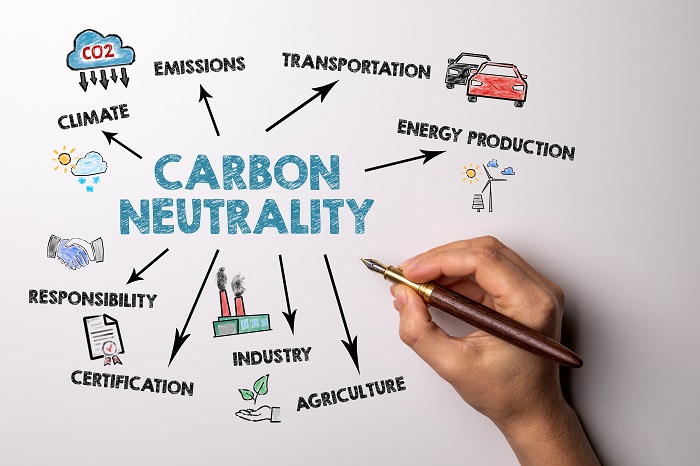
As climate change continues to create widespread disruptions in the form of higher temperatures and extreme weather events, switching to a carbon-neutral lifestyle has become necessary for everyone.
But what exactly is a carbon-neutral lifestyle, and how can you achieve it? Continue reading and find out.
What Does It Mean To Have A Carbon-Neutral Lifestyle?
A carbon-neutral lifestyle means cutting down your greenhouse gas contribution to the atmosphere through a combination of carbon offsetting and reduction.

It’s important to note that being carbon-neutral is different from being carbon-free.
Carbon-free refers to activities and lifestyles that don’t generate any carbon emissions. Conversely, being carbon-neutral means you still produce carbon emissions but use a blend of strategies to help bring down those emissions.
4 Steps To Achieve And Sustain A Carbon-Neutral Lifestyle
Now that you know what it means to be carbon-neutral, here are the basic steps to help you achieve it:
- Calculate Your Environmental Impact
The first thing to do to achieve a carbon-neutral lifestyle is to measure the carbon footprint created by your everyday activities and personal habits. Doing so can help you see where you are regarding carbon emissions and know which areas to improve.
You can use a reliable online carbon footprint calculator to measure your current net carbon emissions. You can also hire a sustainability consulting firm to measure your carbon footprint accurately. In addition, they can assist you in creating an effective plan to reduce and offset your environmental impact and provide support during implementation.
- Start Reducing Your Carbon Footprint
Once you’re aware of your carbon footprint generation, you need to adopt ways to reduce your environmental impact. This step requires lifestyle changes and making the necessary green home upgrades. Here’s how you can do it:
- Green Commute
For most people, transportation habits contribute the most to their carbon emissions. So, consider commuting to work, use eco-friendly alternatives such as riding a bicycle, or invest in an electric car.
- Shop Locally
While online shopping offers convenience, it’s not great for the environment. Why order vegetables from another city when you can get them from your local store? Besides helping reduce your carbon footprint, you’re also supporting the local economy while enjoying fresh, seasonal produce on your plate. .
- Reduce Waste
One of the best ways to offset your carbon footprint is to reduce waste. As landfills become more filled, you need to be strategic in reducing waste and aiming for a zero-waste lifestyle. For instance, composting can help reduce food waste, while transitioning to digital records helps minimize paper and ink use.
- Switch To Green Power
In recent years, numerous homes have sported shiny solar panels on their roof. Between the rising cost of electricity and reducing carbon emissions, solar energy allows homeowners to be more sustainable and eco-friendlier. While installing solar panels may require significant upfront costs, numerous government incentives can help you switch.
- Upgrade Home Appliances
Older appliances are energy hogs. While they may still work perfectly, they’re not as efficient as modern ones. So, if you have enough budget, consider upgrading your home appliances one by one. Always choose items with the Energy Star label to ensure they help in saving energy.
- Maintain A Garden
In a time when deforestation is a big issue, building a garden with trees and shrubs allows you to offset carbon emissions and repair the environment. With gardening, you improve soil and air quality, grow your own food, and add and tend to something beautiful and green instead of taking away from the natural world.
While there are more ways to help reduce your carbon footprint, the above methods can help you start on the right foot.
- Measure Your Progress
An essential step in maintaining a carbon-neutral lifestyle is carefully tracking and monitoring your progress. Recording results is a great way to ensure that you’re moving in the right direction while providing encouragement and motivation to do more. It also allows you to create more goals that can further help you improve your efforts.
- Offset Your Remaining Emissions
Following the above tips and other smart choices can help significantly reduce your daily carbon footprint. However, as you measure your progress, your efforts may not be enough to be carbon-neutral. You’ll still have a carbon footprint that needs offsetting.
In this case, you can invest in carbon offsets to neutralize your remaining carbon emissions. These refer to financial contributions to projects that help reduce overall greenhouse gas levels.
Generally, there are numerous carbon offset projects throughout the world that you can support. From the reforestation of degraded land to creating ecosystem protection initiatives to expanding renewable energy sources, these allow you to balance your emissions and sustain a carbon-neutral lifestyle.
Takeaway
To help slow down the effects of global warming and climate change on Mother Earth, each one needs to step up and bring sustainable practices into their daily life. That said, the above tips can help you start your personal journey toward having a carbon-neutral lifestyle.



